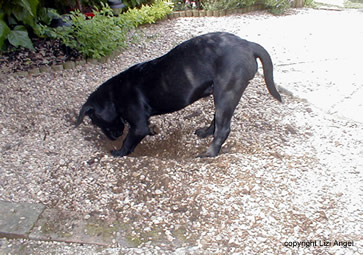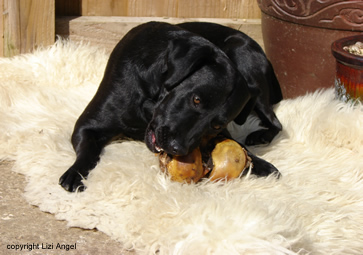STRESS & COMPULSIVE
BEHAVIOUR

IS THE DOG A TRUE PACK ANIMAL?
| Compulsive behaviour
commonly occurs in response to psychological or emotional stress,
and typically involves behaviours that are performed repetitively,
excessively, or out of normal context. Studies in humans and domestic
animals have shown that compulsive, repetitive behaviour decreases
heart rate ~ in other words, compulsive, repetitive behaviour serves
a de-stressing function. Essentially, compulsive behaviours are
coping strategies. Many dogs display compulsive behaviour when under
the influence of frustration, anxiety or conflict, particularly
social conflict.
Compulsive behaviours include excessive appetitive activities such as drinking and eating (food as well as non-food items), other oral activities such as chewing, licking and sucking, locomotor activities such as rooting, kneading, scratching, humping (i.e. pelvic thrusting), digging, shredding, pacing, fence-running, whirling, tail-chasing, and vocal activities such as rhythmic barking and howling. Compulsive behaviour most frequently occurs in dogs that are excessively confined, deprived of adequate mental stimulation, physical exercise and attention, or are exposed to a conflict-dense environment. Compulsive behaviour also appears in highly excitable or nervous dogs where no apparent stress triggers can be identified, suggesting a possible underlying genetic predisposition. Compulsive behaviour most often occurs when a dog's course of action is blocked, during major social transitions such as greetings and departures, or when two opposing emotions or behaviours are evoked at the same time. |
||
 |
Digging is a normal
canine behaviour that is under the influence of the ‘seeking
system’ in the dog’s brain. The seeking system is linked
to the dog’s prey drive (seeking food) and social drive (seeking
interaction, stimulation, etc).
Just like any other form of compulsive behaviour, digging in itself is self-rewarding ~ dogs like to dig because the repetitive movement of the digging action causes the release of various stress-reducing brain chemicals that allow the dog to feel better. The digging of carpets and floors is an example of digging as a compulsive behaviour. It is out of context, never concluding in the unearthing of buried food, escape, or the comfort of a cool, earthy pit to lie in on a hot day, but rather it displaces the dog’s feelings of anxiety and frustraion (perhaps on having its efforts to leave the house with the owner blocked) with the intrinsic ‘feel-good’ factor of the digging action itself. |
|
|
Active-submission behaviour such as jumping
up, pawing, licking, urination upon greeting and various contact-seeking
excesses (e.g. mouthing) are often subject to considerable corrective
or control efforts ~ efforts that aim to prevent or suppress their
expression. Continually ignoring, blocking or punishing active-submission
behaviours without providing the dog with a suitably rewarding
alternative (i.e. using the leadership and affection dimensions
of the human-canine bond) increases social conflict between dog
and owner and introduces significant frustration, thereby providing
the ideal conditions for the development of compulsive behaviour
in these susceptible, active-submissive type dogs.
Compulsive behaviours are often misinterpreted, for example, a dog that humps the legs of family members and guests during greetings and departures is neither dominant nor amorous, but rather it has either found an enjoyable way to displace the anxiety or channel the excitement that it experiences during these major social transitions. The humping behaviour, liberated from the sexual system, serves to substitute the anxiety or channel the excitement with a form of controllable self-gratification ~ a behaviour that often resists interruption, and in some cases evokes an aggressive response upon attempts to stop or correct the dog. Many of the 'problem' dogs that I work with are active-submissive types that have been wrongly labelled by others as being dominant or 'trying to be the pack leader' because they display behaviours such as persistent jumping up, mouthing and humping. |
||
If a dog’s compulsive behaviour
is non-injurious and enables it to successfully handle a stressful
situation, it is debatable whether the behaviour in question should
be labelled as abnormal, however, it should still be taken as a
sign that the dog is under stress and would otherwise not be coping. Providing nervous dogs with a satisfying alternative during potentially stressful situations is a primary way of preventing the development of unhealthy compulsive behaviour. A large marrowbone or stuffed Kong provides the ideal satisfying, long-lasting activity that can enable nervous dogs to cope with the social pressure of having visitors in the home, whilst helping to form a positive association with the additional, temporary company. As with any chew toy or consumable, ensure that the dog remains under your supervision. |
 |
|
|
BACK TO TOP |
||
Copyright
Lizi Angel 2007-2020 |
||